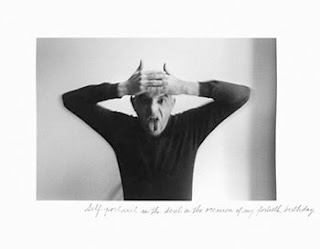By divine lie I mean the ability to create fictions: ideas created in the imagination brought to light as two dimensional graphic stories we call photographs. In the 1960’s and 1970’s there was one photographer that took this idea of story telling to the pinnacle of fine art. His name is Duane Michals.
Michals was born in 1932 in McKeesport, PA to working class parents of Czech descent. His mother worked as a live-in maid for a wealthy family and only saw her family on weekends. Often alone as a child, he delved into his rich imagination, creating an interior world populated with alter egos to keep him company. After serving in the military he spent a year at Parsons School of Design and then began working with magazines as an art director and designer. In 1958, bored and yearning for some larger existence he took the opportunity to travel to Russia, newly opened to tourism. Michals borrowed a friends 35mm camera to use on the trip. Wandering the streets of Leningrad he began taking snapshots and portraits of the people he encountered. Upon his return home, he realized the ennui had not lifted and his life needed a new direction. Photography was his new course.
Michals demonstrated that photography didn’t have to be about a concrete reality. Instead he used the medium to explore philosophical and spiritual beliefs. He wanted to capture the mind’s interior thoughts and all its complex neuroses. He achieved these aims by using a cinematic technique of sequenced images to tell a story over time. He often employed his own hand written comments to elaborate the story, yielding a personal, memoir like effect. Death is a theme often visited in his sequences. He employs blurring as a technique to denote an evanescence of spirit and energy.
Much of Michals work is influenced by surrealism, demonstrated by an abundance of visual non-sequiturs. The surrealist painter René Magritte was both an influence and subject for his photographs.
Equally at ease with commercial and fine art work, he has shot for Vogue, Esquire and Mademoiselle magazines. In 1974 he covered the filming of Robert Redford and Mia Farrow in The Great Gatsby for Vogue magazine resulting in stunning, ethereal photographs of Farrow.


















No comments:
Post a Comment